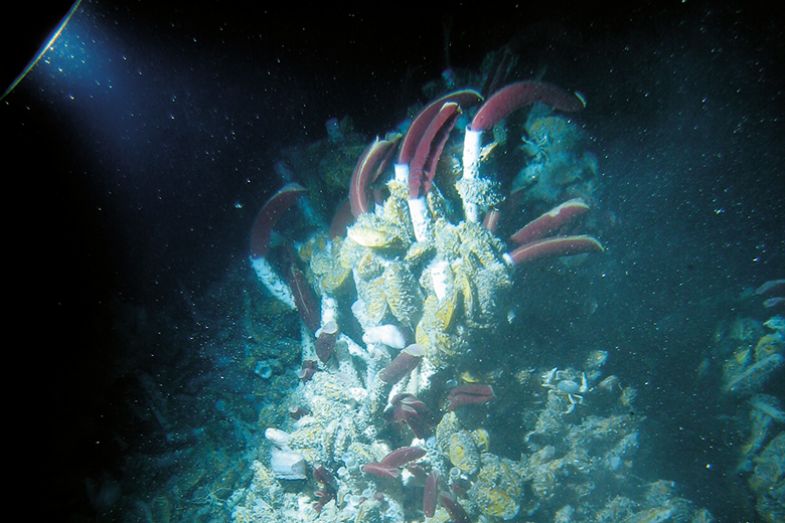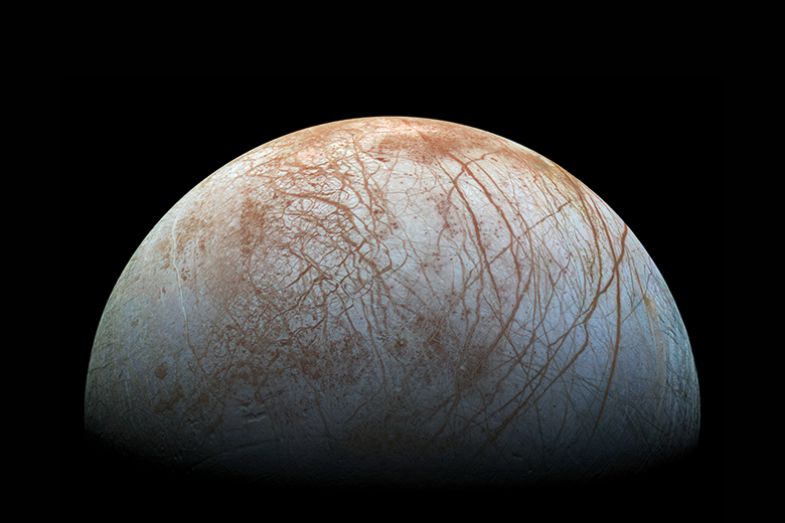The blackness is captivating. It’s hard to pull my eyes away. A vast expanse dotted by points of light shifts in and out of focus as I strain to makes sense of what I am seeing. There’s a twinkle, a flash and a sense of wonder with every moment that passes.
To many, this might sound like the experience of looking up at the night sky, perhaps peering through a telescope. But this is not a description of the stars above but of plummeting to the bottom of the ocean, en route to some of the deepest, darkest and most hostile environments on Earth.
The array of lights that look like stars is the view through my submersible window as gravity pulls it through the water and disturbs the bioluminescent creatures that flash at us. The fireworks are a beautiful display of life itself. It’s like a shimmering wormhole through the ocean, delivering us to our final destination: the hot springs – or hydrothermal vents – on the seafloor that host some of the strangest creatures that Earth has to offer.
It was in 2003, as I describe in my new book, Alien Oceans: In Search of Life in the Depths of Space, that I got a rare opportunity to visit this extraordinary deep-ocean world, when the film director James Cameron needed a young scientist to help him research a film project. I made nine dives in all, near the centre of the Atlantic Ocean, cramped with two other people into a metal sphere two metres in diameter. On one memorable occasion, we lost contact with the other submersible and found ourselves stuck at the bottom of the ocean. The carbon dioxide scrubber was starting to fail, so our little craft was turning into a ball of toxic gas. By the time a faint light appeared in our porthole, and we knew that help was at hand, our oxygen levels were perilously low and the walls of our submersible were dripping with the water condensing out of our breath…

Hydrothermal vents power deep-ocean ecosystems featuring everything from microbes to the tube worms seen here
The discovery of these hydrothermal vents dates back to 1977, just one year after the twin Nasa Viking landers set down on the surface of Mars, the most “Earth-like” of neighbouring planets. At the very moment when we were looking for signs of life in other worlds, we were also learning about unexplored alien ecosystems miles below the surface of our own planet’s oceans.
Then, in 1979, indications of an alien ocean beneath the icy shell of Jupiter’s moon Europa were revealed by the Voyager spacecraft. And the question irresistibly arose: could hydrothermal vents – and perhaps new forms of life – exist in those deep, dark depths too?
Nor are these extraterrestrial oceans confined to Europa. They also exist on the moons of Saturn and possibly of Uranus and Neptune, too. This is one of the most exciting yet underdiscussed discoveries we have made during our near 60 years of exploring our solar system with robotic spacecraft. As I show in Alien Oceans, it has revolutionised the search for life beyond Earth because if we have learned anything from our study of life on our own planet, it is that where there’s liquid water, there’s life. Could these moons be host to a second, independent origin of life? And would that life function with the kind of biochemistry familiar to us, or would it run on something completely different?
For a long time, it was believed that a world could be habitable only if it orbited its star (in our case, the Sun) at just the right distance for the heat of the star to help maintain liquid water on its surface. Too close and you were too hot; too far away and you were too cold. This was the planetary “Goldilocks” scenario.
In the ocean worlds of the outer solar system, however, the energy for maintaining liquid water comes not from a star but from the tidal stretching and heating these moons experience as they get pulled like balls of taffy during their orbits around their massive planets. That gives us vast volumes of potentially habitable real estate. Europa alone has a global ocean about 60 miles deep (10 times deeper than the deepest point on Earth), and its total volume of liquid water is roughly two to three times that of all the Earth’s oceans. Taken together, the oceans within the moons of the outer solar system may harbour upwards of 50 times the volume of water in the Earth’s oceans.
As well as water, however, we need some form of energy to power life. Since ice-covered alien oceans are cut off from the Sun, photosynthesis – which, directly or indirectly, powers just about every living thing we see around us – is not a likely option. It is here that we can learn from our research in Earth’s deep ocean.
What we find is a food chain fed not by photosynthesis but by chemosynthesis: chemical reactions made possible by fluids and gases from hydrothermal vents and the rocks of the seafloor. These reactions power microbial communities, which then feed the larger organisms and make possible the beautiful and bizarre ecosystems I was lucky enough to see for myself.
The Galileo spacecraft’s exploration of Jupiter in the 1990s, followed by the Cassini probe’s examination of Saturn in the 2000s, expanded our scientific understanding of their ice-covered moons and provided enough data to support the hypothesis of geologically active seafloors and chemically rich oceans. For Saturn’s moon Enceladus in particular, Cassini revealed plumes of material jetting out from a subsurface ocean, whose chemistry can be closely tied to hydrothermal activity on a terrestrial rocky seafloor.
Given that nothing has yet landed on the surface of Europa or Enceladus to directly sample their ice, our data are inevitably limited. However, the evidence so far does point towards oceans with comparable chemistry to our own ocean, and possibly even hydrothermal vents that could power deep-ocean ecosystems. So what can we do to find out more? And how can our research on Earth and in space cross-fertilise one another?

Jupiter’s moon Europa
The sequence of missions to explore alien oceans in space is first to fly by and map out the surface of the relevant moon; then to land a robotic spacecraft there to look for signs of life and study the ice shell in detail; and then, hopefully, to send a robotic probe that can drill or melt through the many kilometres of ice and reach the ocean below. Once in the ocean, an autonomous underwater vehicle could be used to search for life within the ocean directly.
These are highly ambitious goals that will require a lot of innovation and dedication to exploration. We are going to have to build and test all kinds of new robotic systems – and the best place to test them will be on, and within, the ice and oceans of planet Earth. Indeed, this would be a great opportunity to revolutionise how we study our own oceans and cryosphere (the part of the planet that consists of frozen water). But it also requires significant change in the way we do science here on Earth.
Traditionally, research in our oceans uses what we might call a brute force approach. Large ships deploy large submersibles and other large tools, which are used to grab lots of samples and bring them back to the surface. Samples are then transported to various labs and universities for detailed study.
In the realm of space exploration, we would call this a “sample return” mission (with samples acquired from a site of interest and brought back to Earth). Yet such missions are very rare. In fact, we have retrieved samples only from the Moon, and we have collected “dust” particles in space. (A mission to grab samples from an asteroid is in progress, and there are also plans for a sample return mission to Mars.) Every other spacecraft that has explored our solar system has done so by looking at a world from afar (so-called remote sensing), or by landing on the surface and analysing samples there, via a payload of instruments. The science is done on site; all that is delivered back to Earth is data from the spacecraft’s antenna: a sequence of zeroes and ones.
Such in situ science missions are relatively rare in ocean exploration. Although partly a question of funding, it is largely the result of a longstanding difference between the two cultures of sea and space.
The oceanic culture of large expeditions with large tools is a symptom of ocean exploration’s close historical ties to naval capabilities. Warships, either in peacetime or after they have been retired, sometimes become research vessels. Look no further than the Challenger Expedition (1872-6), which, among many notable firsts, discovered the deepest trench in our ocean, the Pacific’s Mariana Trench. This was made possible by the British Navy converting the warship HMS Challenger into a research vessel.
As much as we would love to launch large missions and massive landers to other worlds, gravity is the ultimate arbiter of exploration beyond Earth. Physics demands small, low-mass, highly manoeuvrable spacecraft. In addition, once a spacecraft has left Earth’s orbit, there is no fixing it; the robots on board must be robust and have some degree of autonomy. These requirements will not change as we work towards sending robots to alien oceans, but as we continue to develop and test these innovative vehicles on Earth we will hopefully break with traditional ways of doing ocean science and witness a new wave of smaller ships, with smaller robots and instruments, heading out to sea.
Within the next few decades, we may succeed in answering one of humanity’s oldest and most profound questions: are we alone in the universe? At the same time, we need a better understanding of our rapidly changing planet if we are to make the transformative effort required to effectively address climate change. And a cheaper, nimbler “science in situ” approach to deep ocean exploration on Earth, as well as off it, could well help us achieve that understanding.
In other words, the exploration of other worlds may just help us to save our own.
Kevin Peter Hand is a planetary scientist and astrobiologist at Nasa’s Jet Propulsion Laboratory, where he runs the Ocean Worlds Lab (http://oceanworldslab.jpl.nasa.gov), although all views expressed here are solely his own. He is also the author of Alien Oceans: In Search of Life in the Depths of Space, which has just been published by Princeton University Press.
POSTSCRIPT:
Print headline: Under the sea, to the stars
Register to continue
Why register?
- Registration is free and only takes a moment
- Once registered, you can read 3 articles a month
- Sign up for our newsletter
Subscribe
Or subscribe for unlimited access to:
- Unlimited access to news, views, insights & reviews
- Digital editions
- Digital access to THE’s university and college rankings analysis
Already registered or a current subscriber?





